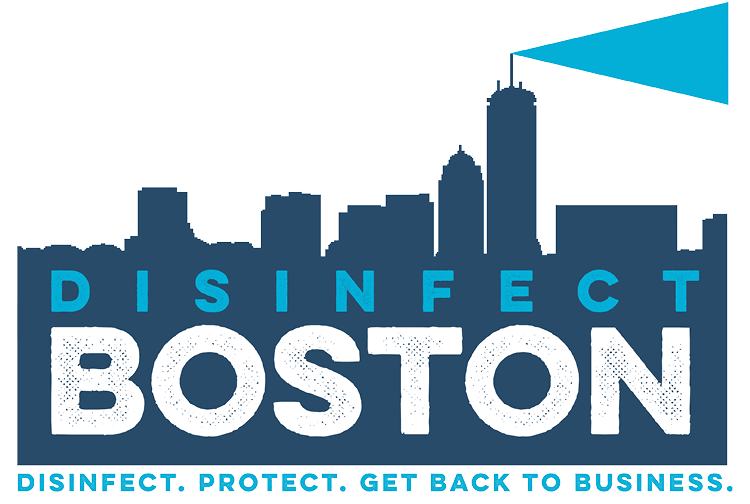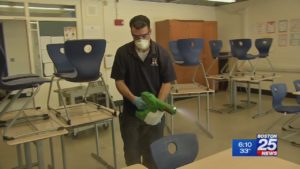FAQ
Disinfect Boston
GET ANSWERS
Frequently Asked Questions
Most frequent questions and answers
Tips and Best Practices to Minimize Your Risk
Cities and states are taking increasingly drastic measures to curb the severity of the pandemic, including the closing of bars, restaurants, and public venues. In some areas, officials have issued “shelter in place” orders in order to compel residents to stay in their homes and limit movement. To further protect yourself, minimize your exposure with the following tips:
Practice Good Hygiene
○ Clean hands with sanitizer and wash your hands frequently
○ Avoid touching your face and cover coughs and sneezes
○ Disinfect “high touch” surfaces like doorknobs, light switches, tables, doorknobs, and
handrails regularly
○ Increase ventilation by opening windows or adjusting air conditioning
At The Office
○ Stop shaking hands – use other non-contact methods of greeting
○ Use video conferencing for meetings when possible
○ When not possible, hold meetings in open, well-ventilated spaces
○ Disinfect “high touch” surfaces like desks, keyboards, light switches, doorknobs, and telephones
○ Consider adjusting or postponing large meetings or gatherings
Stay Home if…
○ You are feeling sick
○ You have a sick family member in their home
Sources:
We believe that the Centers for Disease Control and Prevention (CDC) is the authority on responses to the SARS-CoV-2 virus that causes COVID-19. Their recommendation is to first remove the infected person from your facility. We recommend that they follow their route of entry on their way out and that you provide them with a surgical-type mask to keep them from spreading the virus through coughing and sneezing. Next, isolate the areas that the person visited and remove your employees and others from those areas. Call Aftermath and we will discuss the situation with you and help you develop a plan.
The General Duty Clause of The Occupational Safety & Health Act of 1970 requires employers to furnish to each worker “employment and a place of employment, which are free from recognized hazards that are causing or are likely to cause death or serious physical harm.” 29 USC 654(a)(1).
- According to an OSHA Letter of Interpretation, employers can be cited for violation of the General Duty Clause if a recognized serious hazard exists in their workplace and the employer does not take reasonable steps to prevent or abate the hazard. The General Duty Clause is used only where there is no standard that applies to the particular hazard. The following elements are necessary to prove a violation of the General Duty Clause:
- The employer failed to keep the workplace free of a hazard to which employees of that employer were exposed;
- The hazard was recognized;
- The hazard was causing or was likely to cause death or serious physical harm; and
- There was a feasible and useful method to correct the hazard.
- OSHA outlines standards that relate to handling COVID-19 in the workplace.
- If a COVID-19 infected employee comes to work and infects others, this may be a violation of the General Duty Clause that could lead to a violation if the hazard was recognized and not corrected. Correction would come by quarantine of the infected employee (not allowing him/her to return to work) and a disinfection of the work area.
- Additionally, only the flu and common cold infections in the workplace are exempted from OSHA’s Recordkeeping and Reporting requirements. If an employee is infected by COVID-19 in the workplace, the illness must be recorded on the OSHA 300 Log and if it results in a hospitalization or fatality, it must be reported to OSHA. In the case of a fatality, OSHA will conduct an investigation and a citation and fine could result if the General Duty Clause was found to be violated.
- According to an OSHA Letter of Interpretation, employers can be cited for violation of the General Duty Clause if a recognized serious hazard exists in their workplace and the employer does not take reasonable steps to prevent or abate the hazard. The General Duty Clause is used only where there is no standard that applies to the particular hazard. The following elements are necessary to prove a violation of the General Duty Clause:
While a room fogger may be effective at disinfecting some viruses and bacteria, the CDC currently does not have foggers listed in their disinfection procedure for SARS-CoV-2. The CDC recommends a two-step process that begins with a cleaning of the surface first, followed by disinfection with an EPA Registered disinfectant with emerging virus kill claims.
The CDC reports that the virus has been detected in the air for as much as 3 hours after it is aerosolized and up to 17 days on some inanimate surfaces. Not all surfaces have been tested and it is not yet know how much of the virus material is required to contract COVID-19. CDC currently does not have enough information about SARS-CoV-2 to be able to make a definitive statement on how long to quarantine an area for it to be reduced to an acceptable risk level. For these reasons, the cleaning and disinfection processes described by CDC continue to be the recommendation of Aftermath.
There is no restriction against an employer cleaning and disinfection their own facility; however, there are certain regulatory requirements that must be met in order to be in compliance with OSHA and EPA regulations:
- OSHA’s Personal Protective Equipment (PPE) standards (29 CFR 1910 Subpart I), require training when using gloves, eye and face protection, and respiratory protection.
- When respirators are necessary to protect workers, employers must implement a comprehensive respiratory protection program in accordance with the OSHA’s Respiratory Protection standard (29 CFR 1910.134). This includes a written program, respirator fit tests and medical clearance to wear air purifying respirators. NOTE: Facemasks that are worn to protect others from the spread of pathogens and not to protect the wearer do not have the fit test and medical clearance requirements.
- OSHA has issued a statement regarding COVID-19 Waste: “…use typical engineering and administrative controls, safe work practices, and PPE, such as puncture-resistant gloves and face and eye protection, to prevent worker exposure to the waste streams (or types of wastes), including any contaminants in the materials, they manage. Such measures can help protect workers from sharps and other items that can cause injuries or exposures to infectious materials.” Failure to properly manage the waste could lead to cross-contamination and further infection risks.
- CDC says that most household disinfectants are effective at reducing the risk of infection, but it is important to use only disinfectants that are registered with the EPA. Specifically, those that have emerging virus claims offer the best protection against SARS-CoV-2 pathogens.
- OSHA has recently issued a pamphlet entitled, Guidance on Preparing Workplaces for COVID-19. This document is valuable source of information for employers who want to address the COVID-19 situation. It will help identify at risk employees and provide risk mitigation strategies to employ.
Electrostatics is a branch of physics that studies the phenomena and properties of stationary or slow-moving electric charges (Electrostatics, 2016). Electrostatic phenomena is easily demonstrated when lint is attracted to clothes, or when dust clings to a TV screen.
These descriptions are examples of Coulomb’s law. Coulomb’s law states that opposite electrical charges attract and like charges repel.
Electrostatic spraying has been used for many decades in painting and agriculture. EMist uses this same process to apply a charge to the liquid droplets as they are formed and just before the droplets leave the spray nozzle. These “super-charged” droplets then actively seek out negative or neutral surfaces. What’ more, as the droplets leave the nozzle, the charged droplets repel one another, keeping them from coming together and forming larger droplets. Interestingly, because of the electrostatic charge, droplets “wrap” around surfaces providing an even, consistent surface coverage.
Yes. The sprayers are used in schools, ambulances, hospitality, acute, and post-acute settings.
Electrostatic sprayers can apply any water-soluble chemical. We recommend the use of EPA-registered disinfectant products. A list of EPA registered products that have qualified for use against COVID-19 can be found here.
We recommend EPA-approved organic, nontoxic, biodegradable and safe liquid disinfectants. You can find them by clicking here and then typing “hypochlorous” in the search box.
Cleaning
- Removes germs, dirt, and impurities from surfaces or objects. Cleaning works by using soap (or detergent) and water to physically remove germs from surfaces. This process does not necessarily kill germs, but by removing them, it lowers their numbers and the risk of spreading infection.
Disinfecting
- Kills germs on surfaces or objects. Disinfecting works by using chemicals to kill germs on surfaces or objects. This process does not necessarily clean dirty surfaces or remove germs, but by killing germs on a surface after cleaning, it can further lower the risk of spreading infection.
Sanitizing
- It lowers the number of germs on surfaces or objects to a safe level, as judged by public health standards or requirements. This process works by either cleaning or disinfecting surfaces or objects to lower the risk of spreading infection.
Yes. EPA studies (EPA-600-R-15-279 and USEPA 2015b) show that compared to traditional sprayer systems, an electrostatic spray technology is more efficient, reduces waste, and delivers a more uniform distribution of liquids over uneven surfaces.
Fill out the form and we’ll get right back to you!
Contact
We're Local
Get your company disinfected and clean, ready for business!

